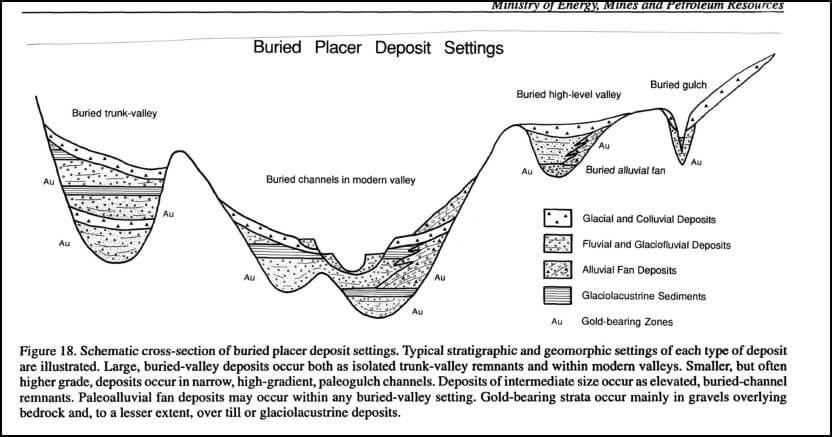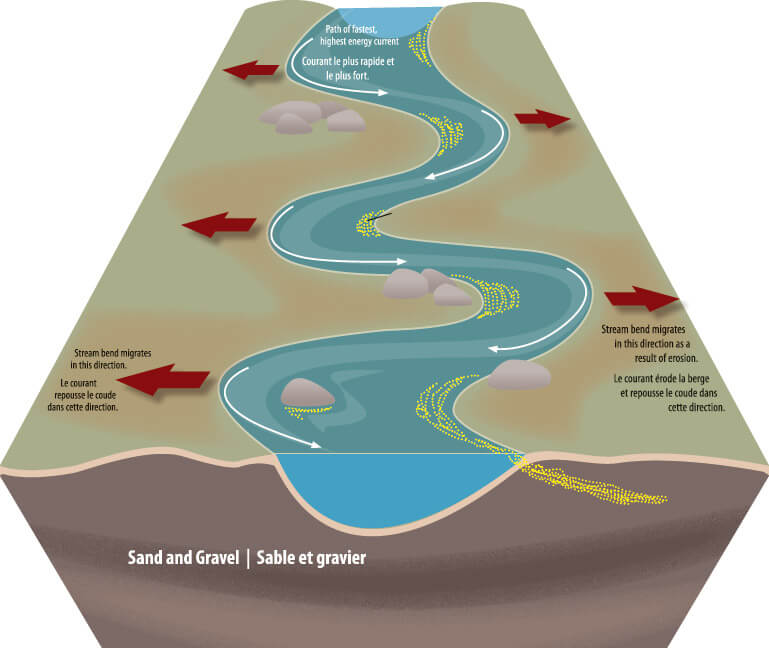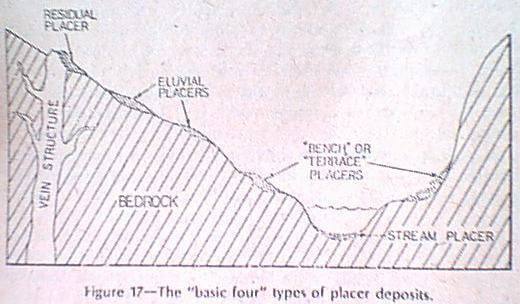Table of Contents
- a. Lodes:
- b. Pre-existing placers:
- c. Auriferous conglomerates and glacial debris:
- d. Magmatic segregations:
- e. Regional rocks:
- How Gold Placer Deposit Formed
- a. Ground water:
- b. Temperature:
- c. Plant growth:
- d. Surface erosion:
- Understanding Streams in Gold Placer Formation
- How Gold Concentrates in Placer Deposits
- a. Bedrock concentration:
- b. Types of bedrock:
- c. Pay Streaks:
- Gold Placer Deposit Preservation Process
- a. Abandonment:
- b. Regional uplift:
- c. Burial:
The source of gold or other minerals found in a placer may be one or more of the following:
a. Lodes or mineralized zones.
b. Erosion of pre-existing placer deposits.
c. Low-grade auriferous conglomerates or glacial debris.
d. Magmatic segregations and associated basic rocks.
e. Regional rocks containing scattered particles of valuable mineral.
a. Lodes:
Although placers are commonly found in lode mining districts, experience has shown that there is no fixed relationship between the richness of the parent lode and the richness or size of resultant placers. Some of the most noted gold mining districts such as Goldfield. Nev., contain no significant placers. On the other hand, some highly productive placer areas are not associated with valuable lodes, the Klondike region being an example. In some cases the lode source may have been completely removed by erosion, while in others, it can be demonstrated that the gold or other valuable mineral was not derived from a single source, but instead, from many small mineralized seams or zones scattered through the bedrock. Although individually unimportant, these smaller sources can collectively furnish substantial amounts of gold.
b. Pre-existing placers:
In many localities old placers have been destroyed by erosion and their gold content reconcentrated in present day streams. Excellent examples are found in the Sierra Nevada region of California. Here, in Tertiary times, beginning some 60 million years ago, there existed an extensive river system, a prolonged time of rock decay, and a good balance between erosion and deposition. These factors combined to form widespread gold placers and some extremely rich bedrock concentrations in the Tertiary streams. Later, as the present Sierra Nevada range was elevated by mountain-building disturbances, new streams flowing toward the west cut across the ancient channels and swept some of their gold concentrations into today’s streams where new, and sometimes richer, concentrations accumulated. Somewhat similar re-concentrations were found in parts of Alaska, the Klondike, and other places.
c. Auriferous conglomerates and glacial debris:
In some placer areas the immediate source of gold is found to be a low-grade auriferous conglomerate or a glacial deposit. With few exceptions such material is too poor to be worked but where appreciable quantities have been eroded, superficial placers may form on the erosion surface or within the local drainage. Wind erosion of an auriferous conglomerate occasionally creates an enriched surface veneer amenable to small-scale, selective mining. Under favorable conditions, gold derived from low-value glacial debris is carried into streams and reconcentrated into minable placers and although some of these re-concentrations have an appreciable extent, most are relatively small and spotty.
Examples of placers derived from low-grade auriferous conglomerates are found in the Red Rock, Goler, and Summit mining districts of Kern County, Calif., (Hulin, 1934) . At Breckenridge and at Fairplay, Colo., gold derived from glacial moraines has been successfully dredged along the Swan, Blue, and South Platte Rivers. According to MacDonald (1910), a gold-bearing glacial till in the Weaverville district of Trinity County, Calif., is an important source of gold for the Trinity River and its tributaries.
d. Magmatic segregations:
Disseminated deposits associated with magmatic segregations in basic rocks seldom generate significant placers but a notable exception is found at Goodnews Bay, Alaska, where extensive platinum placers have been derived from a large mass of dunite and related basic rocks. Although minable placers from basic or ultrabasic rocks may be few in number, they can be important, as shown by the Goodnews Bay platinum deposits where dredging has been carried on since 1937.
e. Regional rocks:

Monazite placers of the type dredged in central Idaho, provide an excellent example of a placer mineral originating as small, sparsely distributed particles in the country rock. Here, monazite, which is a rare-earth mineral chiefly valuable for its thorium content, originates as an accessory mineral in the regional granitic rocks. Following liberation by the usual weathering processes it finds its way into stream deposits, where because of its moderately high specific gravity, it accumulates in placers along with other heavy minerals. Similarly, most of the magnetite, ilmenite, rutile, garnet and zircon associated with gold placers, could be traced to the regional bedrock where such minerals commonly occur as scattered particles or accessory minerals.
How Gold Placer Deposit Formed
The first step in placer formation is release of valuable mineral from its parent rock. The various phenomena which combine to decompose and disintegrate rocks are embraced in the general term “weathering.”
The chief agents of rock weathering are:
a. Ground water.
b. Temperature change.
c. Plant growth.
d. Surface erosion.
a. Ground water:
The great solvent of rocks is, of course, water; particularly ground water that has become charged with products of mineral and vegetable decay. Some rocks such as limestone may be completely dissolved but the majority are more commonly decomposed through the processes of oxidation, carbonation, and hydration.
b. Temperature:
Change of temperature combined with frost wedging plays a part in rock weathering, particularly in desert regions where changes may be rapid and extreme. The effects of frost wedging are readily apparent where it loosens large blocks, but its lesser-known and more important function is the wedging apart of minute rock scales and mineral grains, which in some cases, is an effective agent of rock destruction.
c. Plant growth:
Plants contribute to rock destruction and mineral release in two ways.
- Root growth forces open and extends surface and near-surface cracks and crevices.
- Decaying plants contribute rock solvents to the percolating ground waters.
Decomposing vegetation is a very powerful agent of rock decay and, consequently, wet, humid climates favor the development of deep mantles of decomposed rock and the liberation of placer-forming minerals.
d. Surface erosion:
On the steeper slopes surface erosion becomes more effective and, in turn, chemical rock decay assumes a lesser role in the weathering process. The rapid surface erosion of relatively unweathered rocks in desert regions can result in the formation of placers, but as shown by Lindgren (1933, p. 219), such placers are not often rich or highly concentrated.
Understanding Streams in Gold Placer Formation
Because streams are the dominant agent in the formation of most placer deposits, the field engineer should understand the fundamental processes involved in the movement and deposition of sediments by flowing water. In particular, he should be able to relate stream processes to the mechanics of placer formation. Actually this is a complex subject but several of the more important concepts of stream processes related to placer formation are:
- a. Stream bed erosion occurs only when the flow has the ability to transport more material than is being supplied, and conversely, deposition will begin when the stream becomes overloaded or has its velocity sufficiently checked. Temporary or semi-permanent deposits are usually formed where velocity is locally reduced on the downstream side of rocks or other channel obstructions and along the inside banks of curves. Although at any one point in a stream the balance may be precarious, alternating between erosion and deposition, the net effect will be one or the other. Where there is a net reduction the stream is said to be degrading, and where there is a net deposition it is said to be aggrading.
- b. It can be stated generally that streams do most of their transporting while in flood, and most of their depositing when the floods recede. In general, the coarse material transported by a stream moves intermittently and much of the coarsest material may be at rest for all but brief periods of time. Other things being equal, the length of time between moves and the distance moved is largely a function of particle size.
- c. Stream conditions wherein the entire bed load is shifted or is agitated sufficiently to allow a downward movement of gold particles may occur only during extreme flood conditions or periods of regional climatic change, many years or centuries apart. Nevertheless, bed scour or movement of the whole contents of a stream bed, or of all except the large boulders, is essential to formation of the typical stream placer. Concentration of gold on the bedrock would not be possible without channel scour or a general agitation of the bed load.
- d. Today’s climate and present stream conditions may have little or no resemblance to those which controlled formation of a given placer. Also, it should be borne in mind that old stream deposits such as those of Tertiary age may have no relation to today’s topography or drainage pattern.
- e. In the case of desert placers, the usual rules of stream deposition and of placer concentration are often subordinate to other factors. These conditions are discussed under the heading of DESERT PLACERS.
Longwell, Knopf and Flint (1948) present in concise language, a broad picture of fluvial processes and the movement of alluvial material by streams. Although this reference does not discuss the formation of placers it can serve as a quick review of fundamental principles. Jenkins (1946), in an article titled “New Technique Applicable to the Study of Placers,” discussed stream processes and their relation to placers in considerable detail. This well illustrated article is possibly the best single reference on the subject.
How Gold Concentrates in Placer Deposits
In theory, the richest part of a placer should be found near bedrock and, because of this, many people think that gold placers invariably are richer on bedrock than elsewhere within the deposit. On this basis, they believe that if indications of value are found in the upper horizons, pay gravel will surely be found on bedrock and countless mining ventures have been launched on this premise. Needless to say, many failed. In practice, it is not uncommon to find deposits in which the pay is scattered through a gravel mass without a significant bedrock enrichment. Some deposits, in fact, have their concentrations at the surface rather than on bedrock. This type of occurrence is explained in the section titled “Flood Gold Deposits.”
Another popular idea is that concentration of gold in a stream is analogous to concentration in a sluice box. But in nature the process is by no means this simple as will be shown in following paragraphs.
a. Bedrock concentration:
The development of bedrock concentrations in simple stream deposits may be generalized as follows: Consider a down-cutting stream in which the bedload of sand, gravel and boulders is progressively shifting downstream and subjected to general agitation during times of high water. During high-water periods some of the smaller and lighter particles will be picked up and advanced by the current, usually in a series of short jumps, while the heavier rocks and boulders roll and slide along the bottom. Each time the bed load moves or is generally agitated, the contained gold particles can work downward toward bedrock. Under favorable conditions this may be quite rapid but in many deposits, such bed movements occur only at long-spaced intervals-perhaps not within the lifetime of any one observer. Nevertheless, it must be realized that without such movement and rearrangement of the entire bed load, a downward migration of the gold and, in particular, its eventual concentration on bedrock would not be possible. Under flood conditions fine gold may be swept up and carried away but once coarse gold has settled to the bedrock it is very difficult for the current to dislodge it. For this reason coarse gold is generally found near its source.
b. Types of bedrock:
The ultimate richness of a placer is dependent to a large extent on the physical characteristics of the bedrock. Slates and jointed rocks, particularly those dipping at steep angles are considered most effective in capturing and holding gold. Compact clay, clayey volcanic tuff and decomposed granite make effective bedrocks. A smooth, hard bedrock such as serpentine is generally considered to be a poor gold saver. In some important placer fields, the pay gravels rest on a false bedrock. In the Folsom, California, area, for example, this is usually a layer of volcanic tuff found well above the true bedrock.
Gold works its way into soft or decomposed bedrocks and settles into the cracks and crevices of hard formations. It commonly migrates downward to an extent requiring the mining of several feet of bedrock to effect a complete gold recovery. In some cases, inability to dig a hard, rough bedrock has been the direct cause for failure of dredging ventures. In others, having to dig unexpected amounts of soft bedrock has seriously upset the initial cost estimates. Such possibilities should always be considered when evaluating a placer property.
c. Pay Streaks:
Bedrock enrichments known as “pay streaks” usually follow a sinuous course and sometimes have no discernible relation to the present stream channel. A pay streak may split or terminate suddenly and its lateral limits may be irregular or indefinite, its location and eccentricities being dictated by local controls. Bear in mind that conditions which caused the pay streak, particularly in the case of older deposits, may no longer be in evidence. Pay streaks in gravel-plain or similar widespread-type placers are usually less definite than those in stream placers.
Gold Placer Deposit Preservation Process
Placer deposits do not suddenly come into being but, instead, they are progressively accumulated and enriched by a succession of stream actions and interactions. Although the landforms and geologic controls responsible for the creation of a particular placer may persist for a long period of time (as measured by the affairs of man), the deposit itself is transitory. Unless preserved by some disruption of the normal erosion cycle, the very forces which create the placer will in time destroy it. Knowing how and why a particular deposit was preserved is important to the prospector or mine operator and, obviously, such knowledge is also important to the examining engineer-particularly when he is called upon to project the course of a buried channel or appraise its potential. The more common causes of preservation are:
a. Abandonment:
This is probably the most frequently encountered form of preservation. It is brought about where a stream, by change of course or rapid downward cutting, abandons its former bed and the placers therein. The abandoned placers are preserved in the sense that they are no longer subject to erosion by the parent stream. High bench and terrace gravels provide typical examples of abandoned placers.
b. Regional uplift:
Elevation of the ocean shoreline has in some places preserved beach placers by raising them above the active surf. In some localities, such as Nome, Alaska, elevated beach placers are now several miles inland.
c. Burial:
The lava-capped Tertiary channels found in the Sierra Nevada region of California offer some of the best examples of buried placers but there are means other than volcanic flows by which burial and preservation may be affected. Among these are:
Covering by landslide material.
Covering by flood-plain gravels following regional subsidence or a net change in climate.
Burial under alluvial fans or outwash detritus in desert regions.
Needless to say, a knowledge of past geologic or physiographic events is an important tool in the study of placers.
https://www.angelfire.com/ga4/orlandogpaa/StreamGold.html
